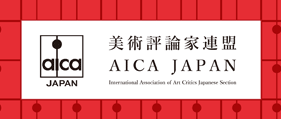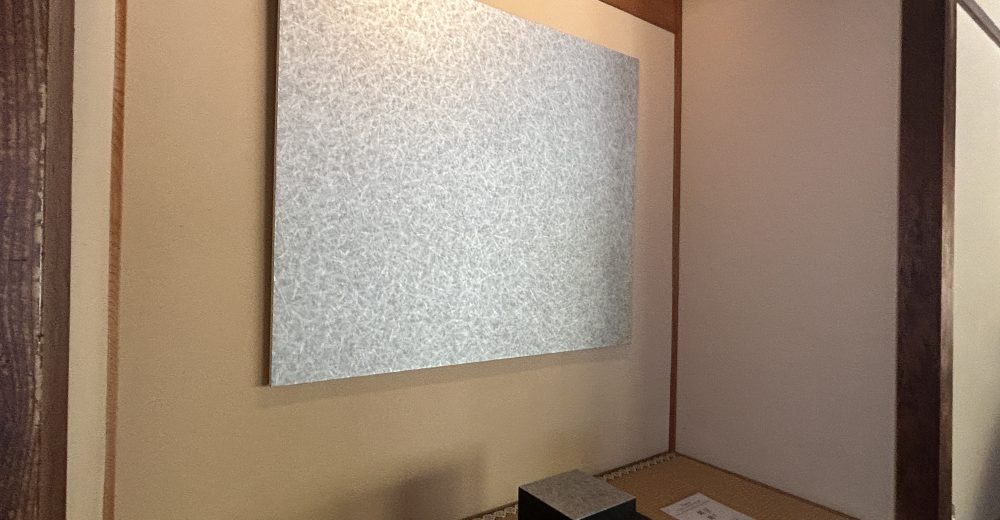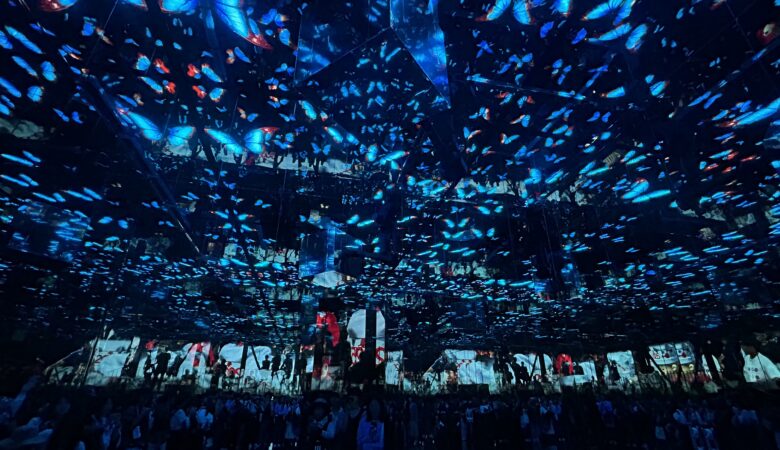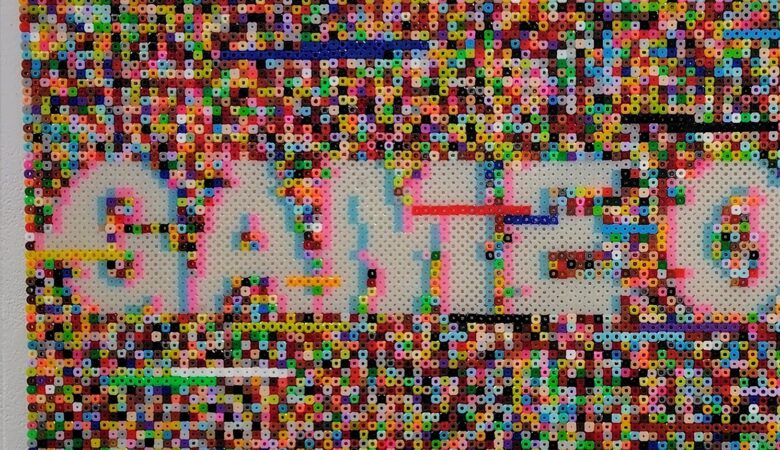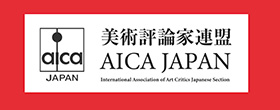
The North Garden of Entoku-in Temple A sub-temple of Kōdai-ji, Kyoto
Tatsuhiro Suizu: Traces
Exhibition Dates: March 14 – May 6, 2025
Venue: Entoku-in (a sub-temple of Kōdai-ji Temple, Kyoto)
From March 14 to May 6, 2025, the exhibition “Tatsuhiro Suizu: Traces” is being held at Entoku-in, a sub-temple of Kōdai-ji in Kyoto. On April 8, 2025, a public conversation took place between Suizu, curator and art historian Tomoki Akimaru, and the temple’s head priest, Shōkō Gotō.
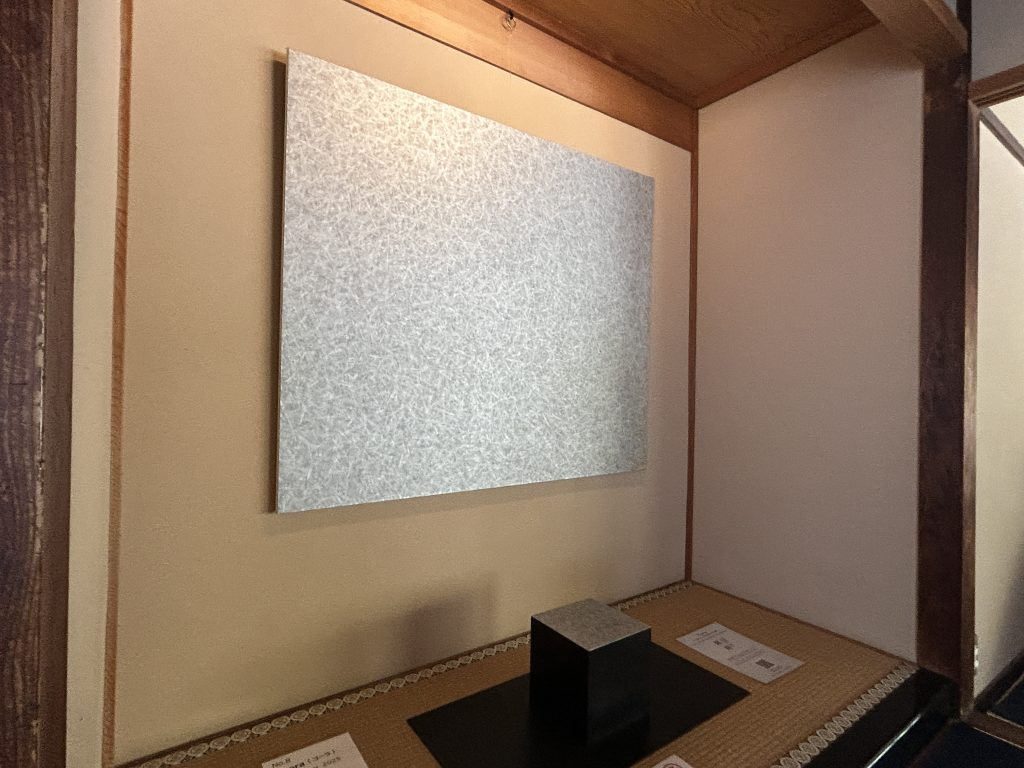
Installation view at Entoku-in
What does it mean today to present contemporary art in a temple? Many of Japan’s art museums were originally built on land once owned by temples and shrines, confiscated or repurposed during the anti-Buddhist Haibutsu Kishaku movement. Although Shinto and Buddhism had been syncretically intertwined, Meiji-era reforms forcibly separated the two. “Seats of the Buddha” were displaced to parks, expositions, and eventually, museums. In Kyoto, for example, the Kyoto National Museum was built on the grounds of Hōkō-ji Temple, Maruyama Park was once part of Anyō-ji Temple, and Okazaki Park was the site of the Six Victory Temples (Rokusho-ji). Given that museums are Western institutions, born out of Christian society, one might say this spatial and cultural transformation replaced the original Buddhist-Shinto syncretism with a new syncretism between Shinto and Christianity.
As this movement subsided, temples and shrines remained, but the modernized and Westernized concept of “art” came to be exhibited primarily in museums. The premodern art ecosystem—where painters were commissioned to create fusuma panels, hanging scrolls, or folding screens for temples and shrines—largely disappeared. While such commissions occasionally still occur, they are treated as rare exceptions, signaling a disruption rather than a continuation of tradition.
Today, both religious sites and the artworks housed within them are largely seen as remnants of the Edo period or earlier. When presenting new works in such contexts, two conditions must be considered: thematic appropriateness and formal harmony. Because temples are places of worship, works that contradict their teachings cannot be displayed. As Reverend Gotō points out, even historical works like ukiyo-e or shunga that affirm worldly desires are unsuitable. Similarly, contemporary art that tackles modern social issues may be difficult to accommodate if it conflicts with religious values.
In this respect, Suizu’s work neither disrupts nor clashes with the temple context, thematically or formally. Yet it is not Zen painting, nor is it reminiscent of idyllic or naturalistic Edo painting or modern Nihonga. Rather, it poses a question: in today’s society, can the pursuit of a “Way” (michi or dō) still be expressed through art?
Temples are places for learning and practicing Buddhism. However, one must ask whether Japanese people have ever fully internalized Buddhist teachings. From the time of Prince Shōtoku, Japan has embraced lay scriptures rather than monastic ones, blending Buddhism with Shinto and ancestral worship—this fusion forms the basis of Shinbutsu shūgō (Shinto-Buddhist syncretism).
Shinto, at its core, affirms life and prosperity in the present world, while Buddhism regards life as suffering—“all is suffering” (issai kaiku)—and seeks liberation through the Three Marks of Existence: impermanence, non-self, and nirvana. The path to liberation (gedatsu) is thus a process of mental discipline: to recognize and dispel illusions and delusions. This discipline gave rise to Zen.
Zen emerged partly as a response to the vast corpus of Mahayana and Theravada texts after the Buddha’s death. It sought a return to the original act of sitting meditation—zazen—as practiced by Shakyamuni himself. Zen principles such as “no reliance on words and letters” and “a transmission outside the scriptures” emphasize direct mind-to-mind transmission between teacher and disciple.
Through kenshō jōbutsu (“seeing one’s true nature and becoming a Buddha”), practitioners are meant to intuitively grasp the universal nature of existence through their lived experience. Esoteric Buddhism (Mikkyō) speaks of sokushin jōbutsu (“attaining Buddhahood in this very body”), and although differing in method, both traditions affirm that enlightenment is discovered in embodied life. This life-centered focus may resonate with Japanese sensibilities. As Western societies—once dominated by guilt, judgment, and a death-centered cosmology—developed modern science and philosophy, they turned toward a “philosophy of life” that in turn both influenced and was influenced by Japanese thought.
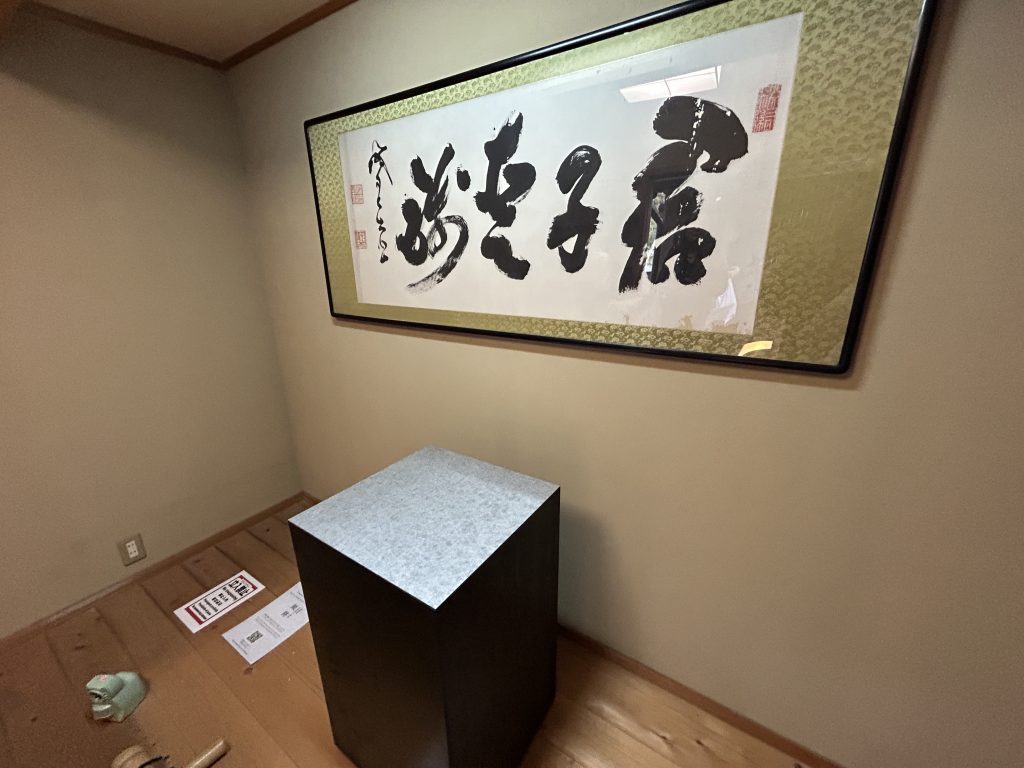
Installation view at Entoku-in
Zen, said to have been brought to China from South India by Bodhidharma, evolved under the Sixth Patriarch Huineng. In contrast to the gradualist (zen-go) approach of the scholar-practitioner Shenxiu, the illiterate Huineng championed sudden enlightenment (ton-go), emphasizing spiritual insight through everyday living. Thus, Zen became not just about sitting meditation but about finding mindfulness in cooking, cleaning, and all acts of daily life. This spirit gave rise to artistic traditions, including Japanese cuisine (notably dashi-based cooking), and continues in the arts that Zen inspired. Japanese Zen masters such as Eisai and Dōgen embraced this holistic approach.
Suizu’s process—filling the canvas with short ink strokes—is described as a means of clearing the mind. It mirrors Zen methods, where repetitive, physically undemanding actions like cooking or cleaning allow the brain to shift from the neocortex to the cerebellum, reducing distractions. His work expresses this Zen-like process of mental purification. Whether or not the resulting images are conventionally “beautiful,” they exhibit a kind of pattern and fluctuation that resonates visually.
Modern scientific studies have noted how Jackson Pollock’s paintings, for instance, exhibit natural patterns such as 1/f noise and fractal self-similarity. Suizu’s work shows similar tendencies, even if subconsciously. In his meditative process, there likely remains a sensibility attuned to balance and beauty—just as the Zen act of cleaning carries with it a latent desire for cleanliness. This balance of micro and macro, process and outcome, may itself be considered a kind of “Way” or eternal path toward truth.
Though Suizu’s method is simple—repetitive short brushstrokes—the final composition may subtly change with the artist’s psychological state. Attempting to control the outcome prematurely may introduce distraction and disrupt the work’s balance. Thus, the journey toward a satisfactory piece is a long and arduous one—a path of discipline akin to spiritual practice.
Another aspect is the resonance with the surrounding environment. In Edo-period Japan, homes and temples had minimal artificial lighting, relying on natural light. As light diminishes deeper inside, reflective materials—like gold or silver leaf and mica—were used to enhance brightness. In this exhibition, Suizu incorporates foil-only works. Reverend Gotō compares their empty spaces to the gold void in the center of Tawaraya Sōtatsu’s Wind God and Thunder God Screens. That emptiness, I believe, alludes to the radiance of the Bodhisattva Kannon—an unseen yet present light.
These reflective materials, constantly changing with external light, symbolize the impermanence of form. Suizu uses gold foil and mica in works that shift with time and season. In a storage room called Mujinzō, he even uses fluorescent materials that glow in darkness. While such materials may seem modern, even traditional pigments like gofun (shell white) contain fluorescent components. Thus, the use of light—through reflection and fluorescence—has deep roots in Japanese tradition.
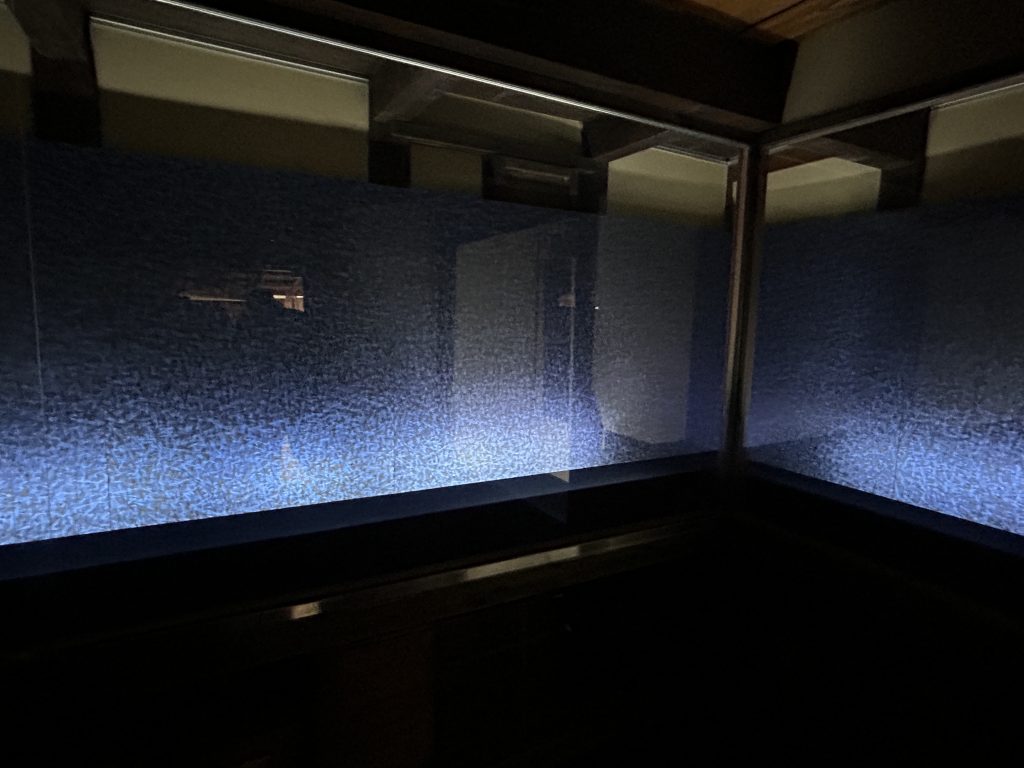
Installation view at Entoku-in
Can contemporary sensibility, technique, and expression revive the lost practice of showing art in Zen temples? Doing so requires more than surface-level trendiness. It demands a profound resonance with the temple’s philosophical depth. In this respect, Suizu has met the challenge, layering new meaning onto history and opening a new path forward.

